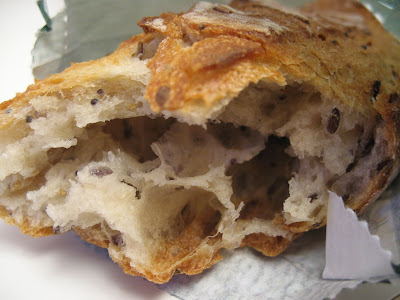
I love the look of the Fifth; it's one of the oldest parts of Paris, so the streets are narrow and winding and the buildings old and beautiful. Unfortunately, the tourists easily outnumber the students in peak season. Much of the area around the Place Saint-Michel is crowded with cheap crepe stands and tacky souvenir shops. (There is one curiosity: la rue du Chat-qui-Peche, Paris's narrowest street). Do yourself a favor and get lost on the winding side streets. It doesn't take more than a few blocks to lose the tourists and enjoy thefeeling of wandering the original Paris.
The 5th is best known as the home of the Latin Quarter, so called because it was home to many Parisian students (who all spoke Latin to one another). Student presence in the area remains strongs. It's still home to the main building of the Sorbonne (Universite Paris IV), which you can explore (caution: It's easy to get lost).
Logically, it's also home to many bookshops. Most students do their shopping under the yellow awnings of Gibert Jeune on the Place Saint-Michel. The librarie/papeterie carries textbooks, paperbacks and other school supplies and is a handy place to pick up cheap books, planners, etc. While Gibert is a one-stop shop for college readings, I can never resist a trip around the corner to visit Shakespeare and Company. I know, it's not exactly a hidden gem. But despite the considerable number of tourists, the store hasn't lost its charm. Founded in in 1951 by American George Whitman, it's become the most famous English bookstore in Paris. Whitman has hosted 50,000 travelers, who slept in the store when they had nowhere else to go. After making your purchases, I'd recommend taking your books next door to the Square Rene Viviani to enjoy the unbeatable view of Notre Dame. (The square is also home to the oldest tree in Paris, a locust tree planted in 1601).
One of the most famous monuments in the neighborhood is the Pantheon, resting place of French luminaries. It's not my favorite monument, but is certainly worth a look. The interior is vast, and filled with an odd mix of revolutionary and religious art and sculpture. It's also where Leon Foucault conducted his famous experiment, demonstrating the Earth's rotation, and you'll find his pendulum hanging from the central dome. Downstairs, you can visit the tombs of Victor Hugo, Voltaire, Jean-Jacques Rousseau, Alexandre Dumas and Emile Zola.
Another, lesser known museum is the Musee de Cluny, which is dedicated to the Middle Ages. Here, you'll find the famous Lady and the Unicorn tapestry series, as well as the original kings from Notre Dame's facade. Yep, sorry to disappoint you, but those statues on the front of Notre Dame are fakes. During the French Revolution, the revolutionaries thought that these sculptures represented the kings of France (they are actually the kings of Judah), so they smashed them to bits. The remnants were used in other construction projects, and weren't rediscovered until 1977. The museum also has a quiet medieval garden, and the ruins of ancient baths from the early days of Paris.
Along with the famous buildings, there are plenty of beautiful outdoor spaces in the 5th. The Musee de la Sculpture en Plein Air (Museum of Outdoor Sculpture) is a great way to walk along the Seine Many of the sculptures aren't especially well known (they're not going to expose the Venus de Milo to the elements), but the proximity to the river makes it a worthwhile stop.
I would highly recommend spending a few hours at La Grande Mosquee de Paris, the largest mosque in France. One of my favorite afternoons in Paris was spent sipping mint tea in its beautiful tearoom. You can also indulge in food and pastries at the mosque's restaurant, or enjoy its steam baths.
Near the mosque, you'll find the Institut du Monde Arabe (Institute of the Arab World). The institute houses a museum, library and restaurant. It also features temporary expositions (On my last day in Paris, I saw an especially interesting one on Hermes window displays).
Nearby is the Jardin des Plantes, a large botanical garden that also contains several natural history museums. It's right next to the Seine, and boasts a huge variety of flowers and other plants.
If you get tired of wandering, there are plenty of places to fill your stomach and rest your feet. If food's what you need, the rue Mouffetard is a good bet. It's a long street packed with market stalls, shops and cafes. It's not a hidden gem: you'll probably encounter other tourists, but it's a bustling spot that hearkens back to traditional Paris.
At the end of the street, you'll find the Place de la Contrescarpe. It's a pretty square filled with cafes that was once favored by Ernest Hemingway. If you're a Hemingway buff, you can also see his first Parisian apartment in the 5th arrondissement at 74, rue Cardinal Lemoine (James Joyce lived at #71 while finishing Ulysses).
If coffee isn't your thing, rest your feet in the Arenes de Lutece. The site could be called a park, but it's really more than that. What the "arenes" (arenas) lack in green space, they make up for in history. Centuries ago, Paris was controlled by the Romans (its name at the time was "Lutece"), and these arenas are the remains of a 1st century Roman amphitheater. No gladiators nowadays, but you can sit in the former bleachers and watch a kid's soccer game...
A final stop: Breakfast in America. If you're short on time in Paris, you can skip this American-style diner, as it doesn't offer much in the way of French culture. But it became a favorite for my friends and I when we needed a hamburger fix. The staff all speaks English, you get unlimited coffee (surprisingly rare in Paris) and their Obama milkshake (chocolate, vanilla and peanut butter) is delicious.












































